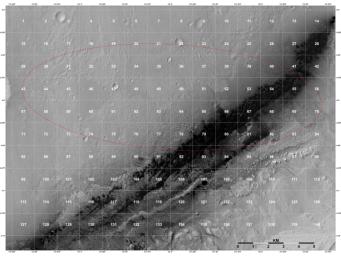
|
Close-up of Curiosity’s Landing Region
- Click the image above for a larger view
- Full-Res JPEG (9000 x 6750) (7.4 MB)
- Full-Res TIFF (9000 x 6750) (182.3 MB)
Caption:
This is a close-up view of the northern two-thirds of one of the quadrangles (number 50) that were mapped onto the landing region of NASA's Curiosity rover. Note the presence of layered deposits around the rim of an impact crater, as well as along a scarp that traces through the center of the quad. These exposures are reminiscent of the terrain studied by NASA's Opportunity rover, where exploration was limited to the layered deposits exposed along the flanks of craters, in addition to NASA's Spirit rover, which studied the layering exposed along a circular scarp known as "Home Plate." The Gale Crater landing region provides access to both types of exposures.
The background image was obtained by the High Resolution Imaging Science Experiment (HiRISE) camera on NASA's Mars Reconnaissance Orbiter.
Background Info:
HiRISE is one of six instruments on NASA's Mars Reconnaissance Orbiter. The University of Arizona, Tucson, operates the orbiter's HiRISE camera, which was built by Ball Aerospace & Technologies Corp., Boulder, Colo. NASA's Jet Propulsion Laboratory, a division of the California Institute of Technology in Pasadena, manages the Mars Reconnaissance Orbiter Project for NASA's Science Mission Directorate, Washington. Lockheed Martin Space Systems, Denver, built the spacecraft.
Cataloging Keywords:
| Name | Value | Additional Values |
|---|---|---|
| Target | Mars | |
| System | ||
| Target Type | Planet | |
| Mission | Mars Science Laboratory (MSL) | Mars Exploration Rover (MER), Mars Reconnaissance Orbiter (MRO) |
| Instrument Host | Curiosity Rover | Mars Reconnaissance Orbiter, Opportunity (MER-B), Spirit (MER-A) |
| Host Type | Rover | Orbiter |
| Instrument | High Resolution Imaging Science Experiment (HiRISE) | |
| Detector | ||
| Extra Keywords | Color, Crater, Impact | |
| Acquisition Date | ||
| Release Date | 2012-08-02 | |
| Date in Caption | ||
| Image Credit | NASA/JPL-Caltech/Univ. of Arizona | |
| Source | photojournal.jpl.nasa.gov/catalog/PIA15957 | |
| Identifier | PIA15957 | |
